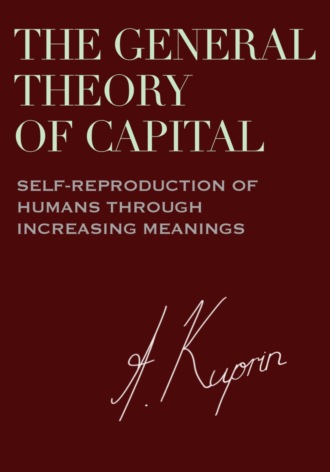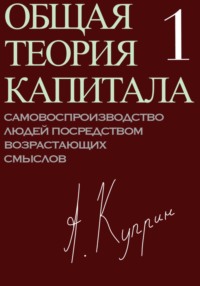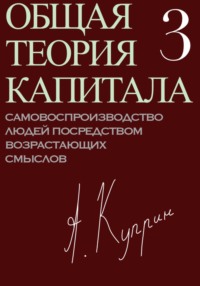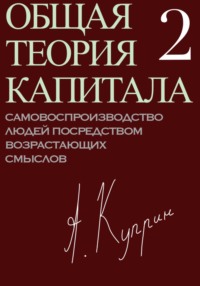
Полная версия
The General Theory of Capital: Self-Reproduction of Humans Through Increasing Meanings
By economy we understand the relationships between people with respect to technology, and the activities that arise from these relationships. The economy is the process by which people accumulate, select and apply technologies: it is the result of a long history of the division of activities or, as it is commonly called, division of labor. It must be clarified that the division of activities consists in a multiplication of material, social and abstract technologies. The division and addition of activities is not reduced to specialization and cooperation: every day new features of this or that activity appear, but not all of them are retained in the socio-cultural order as separate types of activity. Economic activity is not limited to production, it also includes consumption and circulation—insofar as they arise from relationships related to technology and its products.
Social production cannot be based on chance, it requires repeated results and is based on cultural experience and socio-cultural order. Historically, to determine the relationship between needs and products of actions, a notion of normal activity was developed. The norm is a socially determined action that must be performed to reproduce meaning. The plane of the norm connects the plane of content and that of expression and includes both figurae of content and figurae of expression. There is a temptation to equate minimal actions with meanings as such. However, an individual meaning s should not be reduced to the minimal action s*, since it always includes “redundant” figurae of expression and content—the remains of the past and the sources of the future, mistakes and successes of learning or creativity.
We call the mass of meaning the number of figurae in a single meaning, that is, the length of the string L(s) that includes the “redundant” figurae. On the one hand, the mass of meaning depends on the individual characteristics of the acting subject. On the other hand, the necessary mass of meaning depends on the general standard of action. The socially necessary mass of meaning corresponds to the notion of “normal” productivity, defined as the relation of complexity, efficiency and intensity of meaning, where intensity is the number of repetitions of an action per unit of time.
Productivity is the relation of the result of an activity to its actor, process and means. It is a juxtaposition of meaning against itself, a comparison of an action and its result. The nature of meaning implies a certain contradiction, a consistency or inconsistency between an action and its result. One could say that productivity is an indicator of meaningfulness—insofar as meaning can be reduced to the result of an action.
To increase productivity often requires more action, but people are generally unwilling to do more. The principle of least action is one of the fundamental laws of human history:
“Once a particular agricultural system reaches the limits of its productivity, people can decide to migrate, to stay and stabilize their numbers, to stay and let their numbers decline—or to adopt a more productive way of farming. The last option may not be necessarily more appealing or more probable than the other solutions, and its adoption is often postponed or chosen only reluctantly because such a shift almost invariably requires higher energy inputs—in most cases of both human and animal labor. Increased productivity will support larger populations by cultivating the same (or even smaller) areas, but the net energy return of intensified cropping may not increase and may actually decline. Reluctance to expand permanently cultivated land (a choice that entailed higher energy inputs, beginning with the clearing of primeval forests, the draining of swamps, or the building of terraced fields) led to much delayed reclamation of marginal lands” (Smil 2017, pp. 49-50).
Every technology requires the use of energy, but changes in complexity do not depend on changes in the amount of energy used. Mastering more energy does not necessarily lead to an increase in meanings: technologies, organizations and psychologies. “…A deterministic linking of the level of energy use with cultural achievements is a highly arguable proposition” (Smil 2017, p. 3). The fact is that the complication of meanings is often based on social and abstract technologies, the development of which does not require large energy inputs:
“But even in much simpler societies than ours a great deal of labor was always mental rather than physical—deciding how to approach a task, how to execute it with the limited power available, how to lower energy expenditures—and the metabolic cost of thinking, even very hard thinking, is very small compared to strenuous muscular exertion. On the other hand, mental development requires years of language acquisition, socialization, and learning by mentoring and the accumulation of experience, and as societies progressed, this learning process became more demanding and longer lasting through formal schooling and training, services that have come to require considerable indirect energy inputs to support requisite physical infrastructures and human expertise” (Smil 2017, pp. 18-19).
An increased complexity of meanings is not necessarily the result of increased energy use, but the opposite is the case: changes in energy use depend on changes in the complexity of meanings. Increasing complexity requires a more efficient use of energy (cf. Smil 2017, pp. 417-418). Applied to culture-society, the principle of least action is first and foremost an information principle and only then an energy principle.
Productivity improvements are aimed at increasing the efficiency of activity and reducing the volume of activity required to meet needs. This can be done in two ways:
(1) by excluding redundant figurae, that is, by bringing the mass of an action closer to the possible minimum (economy of action);
(2) by complicating the meaning in a way that increases its effectiveness and/or reduces its intensity.
Productivity growth means increasing efficiency and saving labor, including through the use of indirect or roundabout production methods and tools: domestic animals, machines and mechanisms, etc.
The means of activity are an integral part of minimal actions: metal, furnace, hammer, and anvil are necessary elements of blacksmithing; wool and a spindle (or spinning wheel) are necessary for spinning. The elaboration of the means increases the complexity of the action: if means are lacking, one must first expend activity to produce them. In other words, the complexity of minimal production actions (e.g., blacksmithing or spinning) includes the complexity of the actions to produce their means of production. Similarly, the complexity of minimal consumption actions includes the complexity of consumer articles: before goods can be consumed, they must be produced.
The phase of technological development that began with the transition from hunting and gathering to herding and farming, brought with it a decrease in the intensity of activity and an increase in its complexity. Agricultural evolution was also the evolution of man himself: it reduced the intensity of his activity and changed his skeleton:
“A great deal of traditional farming required heavy work, but such spells were often followed by extended periods of less demanding activities or seasonal rest, an existential pattern quite different from the nearly constant high mobility of foraging. The shift from foraging to farming left a clear physical record in our bones. Examination of skeletal remains from nearly 2,000 individuals in Europe whose lives spanned 33,000 years, from the Upper Paleolithic to the twentieth century, revealed a decrease in the bending strength of leg bones as the population shifted to an increasingly sedentary lifestyle. This process was complete by about two millennia ago, and there has been no further decline in leg bone strength since then, even as food production has become more mechanized, an observation confirming that the shift from foraging to farming, from mobility to sedentism, was a truly epochal divide in human evolution” (Smil 2017, p. 53).
In contrast to small foraging groups, large agricultural communities are more complexly organized and can better reduce labor intensity through the allocation of labor and energy. Productivity growth in traditional farming is based both on more intensive use of land and on more complex labor through the use of draft animals, irrigation, fertilization and crop diversification:
“No quest for higher yields could succeed without three essential advances. The first one was a partial replacement of human work by animal labor. In rice farming this eliminated usually only the most exhaustive human work as tedious hoeing was replaced by deep plowing using water buffalos. In dryland farming animal labor replaced human labor and sped up considerably many field as well as farmyard tasks, freeing people to pursue other productive activities or to work shorter hours. This prime mover shift did more than make the work quicker and easier; it also improved its quality, whether in plowing, seeding, or threshing. Second, irrigation and fertilization moderated, if not altogether removed, the two key constraints on crop productivity, shortages of water and nutrients. Third, growing a greater variety of crops, either by multicropping or in rotations, made traditional cultivation both more resilient and more productive” (Smil 2017, p. 65).
The use of draught animals, irrigation and fertilization make activities more complex, as they require growing fodder, building canals, collecting fertilizer, etc., so the size of the minimal action strings increases. At the same time, the intensity of agricultural labor decreases, which is reflected in the human skeleton.
Socio-cultural order and justice
Meaning as action produces products. Meaning as activity produces culture-society and its order. Socio-cultural order as a set of technological, organizational and psychological norms provides the context in which the evolution of meanings occurs. Cultures-societies are products of evolution and as such they are as ordered (or messed) as is appropriate for their functioning. Like all meaning, order cannot be reduced to a minimal action; it always contains redundant figurae—the remains of past orders and the sources of future orders. This means that in a culture-society there are always several competing orders.
Marx identified three modes of production in pre-capitalist societies: the Asiatic, the ancient (slave-holding) and the feudal. However, the order is not limited to modes of production. Kojin Karatani proposed to look at the economy in terms of modes of circulation rather than modes of production. Historically, the mode of circulation in the earliest societies was based on the reciprocity of gifts. With the formation of the state, the mode of circulation based on the exchange of obedience for protection, tribute for redistribution, increasingly became the most important (Karatani 2014, p. 70). For a traditional society, there are many orders that depend not only on the mode of production or circulation, but also on the form of consumption—for example, on the type of staple food:
“…I think, that state formation becomes possible only when there are few alternatives to a diet dominated by domesticated grains. So long as subsistence is spread across several food webs, as it is for hunter-gatherers, swidden cultivators, marine foragers, and so on, a state is unlikely to arise, inasmuch as there is no readily assessable and accessible staple to serve as a basis for appropriation” (Scott 2017, p. 22).
The characteristics of such a staple food are (1) the possibility of being taken away from the producer; for example, wheat, which must be harvested in time, and not tubers, which remain in the ground for years and are edible; and (2) a specific harvest time; here, too, it is wheat, and not, for example, legumes (Scott 2017, p. 22). The measurability and divisibility of the harvest, the possibility of calculating yields and taxes, is a key prerequisite for the emergence of the state. Wheat, barley, rice, millet and corn were the “premier political crops” (Scott 2017, p. 131):
“One might be tempted to say that states arise, when they do, in ecologically rich areas. This would be a misunderstanding. What is required is wealth in the form of an appropriable, measurable, dominant grain crop and a population growing it that can he easily administered and mobilized” (Scott 2017, p. 24). “…The embryonic state arises by harnessing the late Neolithic grain and manpower module as a basis of control and appropriation” (ibid., p. 116).
The technologies necessary for the emergence of political organization are not limited to the use of purely natural effects such as grain cultivation. Social and abstract technologies based on cultural effects (e.g., writing) were crucial both for centralized recording and calculation and for the formalization of political norms:
“The entire exercise in early state formation is one of standardization and abstraction required to deal with units of labor, grain, land, and rations. Essential to that standardization is the very invention of a standard nomenclature, through writing, of all the essential categories—receipts, work orders, labor dues, and so on” (Scott 2017, p. 144). “Claude Levi-Strauss wrote thus: Writing appears to be necessary for the centralized, stratified state to reproduce itself … Writing is a strange thing … The one phenomenon which has invariably accompanied it is the formation of cities and empires: the integration into a political system, that is to say, of a considerable number of individuals … into a hierarchy of castes and classes … It seems to favor rather the exploitation than the enlightenment of mankind” (ibid., p. vi).
Meanings, including writing, do not arise and grow for the enlightenment or exploitation of humanity. They increase insofar as is necessary or sufficient for the self-reproduction of cultures-societies. Economy emerges in relation to technology, policy—in relation to organization: economic action means choosing technology, political action means choosing organization. Politics is the selection of institutions in the competition between people, their needs and motives. As Daron Acemoglu and James Robinson say, “politics is the process by which a society chooses the rules that will govern it” (Acemoglu and Robinson 2012, p. 79). The division and addition of technology goes hand in hand with the division and addition of order, with the emergence of new norms and the increasing complexity of order.
If technology is based on the use of effects, then organization is based on the regulation of relations between people, i.e. on command or disposal. Historically, the first form of economic organization was application or disposal in the process of use: if a thing is not used immediately, it can be taken by someone else. When the natives tried to take things from the ships of the Europeans in the Age of Discovery, they were thieves to the Europeans, although the natives themselves only wanted to use things that the Europeans were not using. Further division and addition of order lead to the second form—possession. Possession is the disposal of the user, not tied to the process of use. The possessor disposes of the thing on the basis that he uses it from time to time. Finally, the third form is property. The owner disposes of the thing, although he himself may not use it at all.
Political organization evolves hand in hand with economic organization. Command over people develops along with disposal over things. The first form of political organization (or polity) is a community in which activities are carried out more or less cooperatively. It is a common economy that grows in the context of application and administration based on experience. The second form of polity is chiefdom, in which application is complemented by possession, and the rule of the experienced is complemented by the domination of the strong. Mansur Olson’s concept of the “stationary bandit” can be applied to chiefdom. When a nomadic band becomes sedentary, it begins to take only a portion of the products of the population and provides protection from other bands, increasing production in the area it controls:
“In fact, if a roving bandit rationally settles down and takes his theft in the form of regular taxation and at the same time maintains a monopoly on theft in his domain, then those from whom he exacts taxes will have an incentive to produce. The rational stationary bandit will take only a part of income in taxes, because he will be able to exact a larger total amount of income from his subjects if he leaves them with an incentive to generate income that he can tax” (Olson 1993, p. 568).
The chiefdom is less dependent on experience and tradition than the community, and it allows people more opportunities to choose their institutions. It thus sets the stage for the third form of political organization—the state. In the state, application and possession are complemented by property, and power relations are built on tradition and violence as well as formal administration and religion. No state arose without a turn to the supernatural. Like chiefdoms, states did not arise as a result of one-off actions. “‘Stateness,’ in my view, is an institutional continuum, less an either/or proposition than a judgment of more or less” (Scott 2017, p. 23). James Scott notes that one of the main tasks that the first states had to solve was to prevent the flight of the population. The border, along with the administrative apparatus, is the distinguishing feature of the state as a political organization (cf. Scott 2017, p. 118). “Some have even argued that state formation was possible only in settings where the population was hemmed in by desert, mountains, or a hostile periphery” (Scott 2017, p. 23).
As the state developed into a comprehensive domain of abstract and social technologies, norms, and mechanisms for their implementation, the formal order became more homogeneous, pushing alternative patterns into the geographical and socio-cultural periphery of a culture-society. The periphery, in turn, refused to adopt complex technologies and organizations from the core of the state for fear of enslavement (Scott 2017, pp. 148-149). States themselves, however, were islands in a sea of non-state populations and had to be wary of their peripheries:
“…The very first states to appear in the alluvial and wind-blown silt in southern Mesopotamia, Egypt, and the Yellow River were minuscule affairs both demographically and geographically. They were a mere smudge on the map of the ancient world and not much more than a rounding error in a total global population estimated at roughly twenty-five million in the year 2,000 BCE. They were tiny nodes of power surrounded by a vast landscape inhabited by nonstate peoples—aka ‘barbarians’” (Scott 2017, p. 14).
Barbarians were not just primitive hunters and gatherers, they were the “dark twins” of the states that evolved alongside them. The barbarians formed sprawling chiefdoms, confederations of nomadic pastoralists who lived from raids on grain-growing centers, from mercenaries and from trade:
“The barbarians, broadly understood, were perhaps uniquely positioned to take advantage—and in many cases direct charge—of the explosion in trade. They were, after all, by virtue of their mobility and dispersion across several ecological zones, the connective tissue between the various sedentary cereal-intensive states” (Scott 2017, p. 248). “The early agrarian states and the barbarian polities had broadly similar aims; both sought to dominate the grain-and-manpower core with its surplus. The Mongols, among other raiding nomads, compared the agrarian population to ra’aya, ‘herds.’ Both sought to dominate the trade that was within reach. Both were slaving and raiding states in which the major booty of war and the major commodity in trade were human beings. In this respect they were competing protection rackets” (ibid., pp. 244-245).
The transition from community to chiefdom and state is closely linked to the growth of human population and its density, as well as to the clash of communities among themselves. For a member of an isolated community, the tribe is identical with all of humanity: there are no people outside it. In a community, trust and justice are based on blood ties and common destiny. “Pastoralists in particular have remarkably flexible kinship structures, allowing them to incorporate and shed group members depending on such things as available pasture, number of livestock, and the tasks at hand—including military tasks” (Scott 2017, p. 235). However, the kinship-based socio-cultural order has limits beyond which formal order begins. The transition from a family community to a society of strangers undermines the natural order as the basis of trust and justice and requires a human-made order based on administration and religion.
In contrast to a community, a society is not humanity, it is not the unity of all human beings. Society is a mechanical and abstract association of a few, not an organic and concrete association of all. Ferdinand Tönnies famously distinguished between community and society:
“The relationship itself, and the social bond that stems from it, may be conceived either as having real organic life, and that is the essence of Community [Gemeinschaft]; or else as a purely mechanical construction, existing in the mind, and that is what we think of as Society [Gesellschaft]. … All kinds of social co-existence that are familiar, comfortable and exclusive are to be understood as belonging to Gemeinschaft. Gesellschaft means life in the public sphere, in the outside world. In Gemeinschaft we are united from the moment of our birth with our own folk for better or for worse. We go out into Gesellschaft as if into a foreign land” (Tönnies 2001, pp. 17-18).
Trust is the necessary condition of coordinated action and cooperation both in the personal community and in the impersonal society. However, the impersonal order requires new foundations for trust. Administration does not create political power as a counter to the power of society. In fact, it creates society itself for the first time, transforming people—priests and rulers—into the meanings and centers around which the formation of society took place. Laws and dogmas changed the sources of identity and trust, that is, they extended social norms to an indefinite circle of people united by a common citizenship and faith. With their emergence, trust went beyond the narrow circle of the community and extended to an unlimited circle of the fellow citizens and fellow believers:
“One current theory holds that modern world religions, such as Christianity and Islam, were able to spread precisely because they effectively enculturated norms of prosocial behavior which galvanized large-scale cooperation among relatively anonymous strangers (Atran and Henrich, 2010). According to this view, followers of modern world religions, such as Christianity and Islam, will be more likely to have internalized these norms of prosocial behavior and will thus treat anonymous others with greater fairness and generosity” (Hruschka and Henrich 2013, p. 5).
Trust is based on common norms: legal, religious, ethical, etc. It is common morality that ensures the unconstrained and unconditional unity of human beings, which results from belonging to a common culture, that is, to a single universe of norms and identities. Morality as a practice that takes shape in the space between instincts and reason is part of what Hayek called “extended order,” a spontaneous result of human action but not of human design:
“I prefer to confine the term ‘morality’ to those non-instinctive rules that enabled mankind to expand into an extended order since the concept of morals makes sense only by contrast to impulsive and unreflective conduct on one hand, and to rational concern with specific results on the other” (Hayek 1988-2022, vol. 1, p. 12).
The community is a unity of individuals and humanity; society creates a gap between them. This gap is filled by social categories that develop on the basis of common identities of people and their common social actions. Social classes are only one kind of social categories. The development of culture-society is not driven by the struggle of classes, but by the gap between society as a whole and individuals; and social categories are the necessary mediator that holds society and individuals together, connects individuals with each other. The pursuit of the ideal, of the unity of individuals and humanity, is the driving force of all socio-cultural development:






